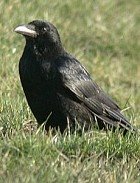corvidae
For a moment it seemed like a battle of wills. The crow was in the road ahead, pulling a string of red flesh out of the squirrel, showing every sign of serene preoccupation. I wondered whether I'd have to slow down. At the last second the crow made a couple of lazy flaps to the side of the road. By the time I could fix him in my rear-view mirror, he was back on his food.
It's surprising how rarely you see a squashed crow (or rook or magpie or jackdaw). But what really impresses me isn't their road safety record as such - good as it is, they probably get run over more often than humans. What's really impressive is that it's so good even though they seem completely unaware that eating your food on the public highway puts you in danger.
When human beings don't know they're in danger, it usually means something bad's about to happen. - which is why you never take your eye off your toddler in the street. The toddler hasn't yet learnt about all the anxiety and mental tension that's required to be safely around road traffic, so we have to do that part for her. The crow seems to be in the same blissfully anxiety-free state as the toddler, - only the crow doesn't seem to get killed.
I suppose crows just instinctively take flight when any large object comes into their personal space. They couldn't not do it if they tried, and it probably doesn't even break their train of thought. So danger doesn't really come into it..

Still, granted that this wonderful road-sense is mainly just blind instinct, the behaviour of these Corvidae keeps reminding me - disquietingly, in a way, - of human beings. They seem intelligent and they seem intelligent in a human kind of way, if you see what I mean.
I think this must be related to their scavenging, opportunistic way of life. There are birds, like kestrels, who go out and make things happen. Kestrels are fine-tuned and ultra-skilled, but you sense they lack mental elbow-room.
Crows don't make things happen; mostly, they sit around waiting for someone else to make something happen. With a reporter's nose they have to develop a sense of when and where that might be. They watch the world in an unexclusive manner. When they see something, they have to decide if it could be good for them. These kind of fuzzy deliberations are one of the things about crows that remind me of humans.
And then, there's the social side. That's two-fold. First there's all that waiting, which promotes leisure and company. Secondly, when the nutritious event occurs there's often too much food for one individual. Crows don't usually need to be secretive and jealous, in fact have developed many tolerances. You can imagine their gallows humour, hunched over a bar fire.

Watching a blowy rookery as the light dims is a joyous sight. There is nothing alternative about a rook's lifestyle, so far as I know. But these very conventional families love to live all over each other and to roam loudly back and forth on pointless trips. It's like watching a housing estate with all the roofs off, or like when we stay on a campsite. Then, the trampled grass lanes, the streetlife that we spontaneously create as we join each other's barbecues - yes, that in particular reminds me of a rookery.
Labels: Birds



0 Comments:
Post a Comment
<< Home